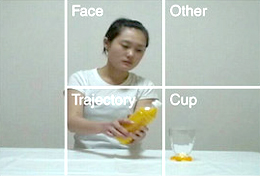Research Abstract
ヒトとチンパンジーは、他者の目的指向的行為を見るときの注意の向け方が異なる
Humans and chimpanzees attend differently to goal-directed actions
2012年2月21日 Nature Communications 3 : 693 doi: 10.1038/ncomms1695

ヒトは、意図などの他者の心的状態を推測することで、その行為を理解する。しかし、こうした能力がどのように発達するのか、また、こうした能力がヒト以外の動物にも同じようにみられるかどうかについては、ほとんどわかっていない。我々は、こうした能力の個体発生およびその進化史的的基盤を解明するため、生後8か月と12か月のヒト乳児、ヒト成人、チンパンジーを対象に、ある目的に向かう行為(目的指向的行為)および明確な目的のない行為を映したビデオを見せた。その時の視線の動きを分析したところ、チンパンジーはヒト成人と同じように、行為の目的が達成される前にその目的を予測していることがわかった。しかし、ヒトとチンパンジーでは、行為に向ける視線パターンは異なっていた。ヒト、特に乳児はチンパンジーに比べて、他者の顔に視線を多く向けていた。ヒト成人では、他者の顔への注意は、目的が達成されるまでは高いものであったが、行為達成後には減少した。目的が明確でない行為に対しては、ヒト成人が他者の顔に注意を向ける頻度は、目的のある行為に比べて少なかった。これらの知見は、ヒトが他者の目的指向的行為を見る際には、操作されているものおよび他者からの情報を統合して処理する可能性を示している。
- 京都大学大学院教育学研究科
- 科学技術振興機構(JST)戦略的創造研究推進事業(ERATO)
- エクス・マルセイユ第1大学(フランス)
- 林原類人猿研究センター
- 京都大学霊長類研究所
Humans comprehend the actions of others by making inferences about intentional mental states of another. However, little is known about how this capacity develops and whether this is shared with other animals. Here we show the ontogenetic and evolutionary foundations of this ability by comparing the eye movements of 8- and 12-month-old human infants, adults and chimpanzees as they watched videos presenting goal-directed and non-goal-directed actions by an actor. We find that chimpanzees anticipate action goals in the same way as do human adults. Humans and chimpanzees, however, scan goal-directed actions differently. Humans, particularly infants, refer to actors' faces significantly more than do chimpanzees. In human adults, attentional allocation to an actor's face changes as the goal-directed actions proceed. In the case of non-goal-directed actions, human adults attend less often to faces relative to goal-directed actions. These findings indicate that humans have a predisposition to observe goal-directed actions by integrating information from the actor.

